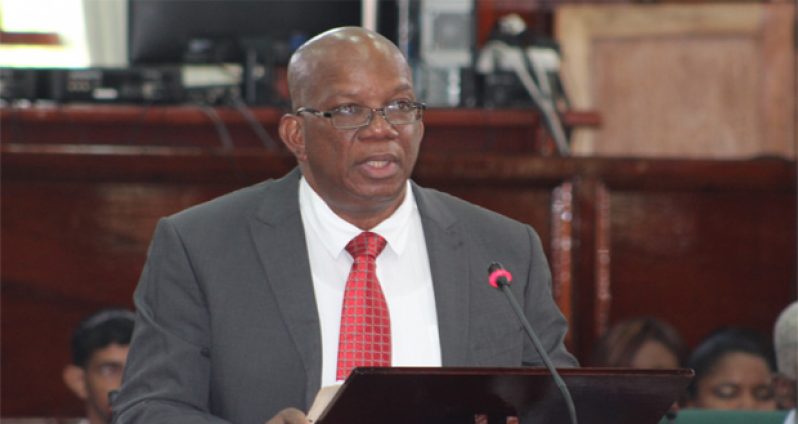…commends resilience of economy despite global headwinds
The International Monetary Fund (IMF) is urging Guyana to expand its economic diversification programme even as it said that the macroeconomic outlook here is generally positive for this year and projected a 4 percent growth to be supported by public investment and two new large gold mines.
The IMF’s statements are contained in a report by its Executive Board following consultations on the local economy. President David Granger had told Parliament back in January that 2016 presents a new opportunity for Guyana to “hasten economic development” by diversifying the traditional sectors and getting into more value-added enterprises. “It is time for a fresh start–a new beginning. It is time to redouble our efforts to eradicate poverty. Our government is committed to promoting sustained economic growth with enhanced distributive justice so that inequalities are reduced and opportunities are increased,” the President said, in an address to the Eleventh Parliament.
The Bank said that twelve-month inflation is expected to remain low at around 2.1 percent by year-end. It said too that the 2016 budget reverses the fiscal stance, envisaging an overall deficit of 5.5 percent of GDP, driven by a 4 and a 2.1 percentage point increase in the shares of capital and current spending in GDP, respectively.” According to the IMF revenues are projected to remain broadly flat, noting that lower oil prices improve the outlook for the current account deficit, which is projected to remain at about 4½ percent of GDP in 2016, financed by investment inflows and donor-supported investment. Reserve cover is projected to increase to 3.8 months of imports at end-2016.
The Executive Directors commended the resilience of Guyana’s economy, which continues to grow despite global headwinds. They noted, however, that challenges and risks remain, and encouraged the authorities to build up fiscal buffers, implement structural reforms, and strengthen the financial sector. Directors welcomed the positive medium term outlook underpinned by an environmentally sustainable and socially inclusive growth strategy.
Directors welcomed too what they described as the marked improvement in the current account, while noting that Guyana remains vulnerable to changes in commodity prices due to its dependence on imported oil and the concentration of exports on a few commodities. They noted that the exchange rate appears to be broadly in line with fundamentals, and underscored that exchange rate flexibility should play a larger role in helping Guyana cope with external shocks.
Directors stressed the importance of fiscal consolidation in order to safeguard debt sustainability and preserve fiscal and external buffers while maintaining growth momentum. They also recommended that fiscal consolidation efforts focus on moderating the growth of current expenditures, in particular transfers to public enterprises, so as to preserve space for public investment while protecting social spending. On the revenue side, efforts to broaden the revenue base and strengthen tax administration were encouraged. Directors welcomed the efforts to reform public enterprises, notably the sugar and electricity companies, in order to improve efficiency and reduce reliance on government support.
Directors encouraged the authorities to move toward greater economic diversification by advancing reforms to promote competition and improve the business climate. Given that the high costs of electricity, transportation and telecommunications have been longstanding impediments to growth, the IMF said it supported well targeted public investment and liberalising reforms to lower costs and raise productivity. Directors noted that the largely concessional nature of debt contributes to resilience and should be preserved. They also commended the authorities for taking a cautious approach in factoring in possible future oil income in their medium term fiscal plans.
Directors concurred that the monetary policy stance should remain accommodative, as lower prices for imported goods, including fuel, continue to ease inflationary pressures.
Additionally, the Bank said while the banking sector appears well capitalised, directors recommended heightened vigilance given the rise in nonperforming loans, as well as tightening of provisioning requirements and close monitoring of related party lending. They looked forward to a more granular analysis of financial sector challenges by the upcoming FSAP mission. Directors stressed the importance of strengthening the anti-money laundering and combating the financing of terrorism framework. They noted that remaining deficiencies amplify the vulnerability to de risking, which will require greater international effort to address.
They urged the prompt implementation of the action plan agreed with the Financial Action Task Force.
Meanwhile, the IMF said real economic activity here expanded by 3 percent in 2015. It said lower export commodity prices and budget delays weighted down on activity, while the opening of two new large gold mines helped support growth. Consumer prices contracted by 1.8 percent in the twelve months ending in December 2015, reflecting lower import prices and a one-off increase in VAT exemptions.
The overall non-financial public sector deficit narrowed to 0.2 percent of GDP in 2015 from 5.7 percent in 2014. Despite the slowdown, revenues as a share of GDP increased by 4.2 percentage points, buoyed by fuel excises (which were raised as the international oil price declined), and one-off increases in non-tax revenues. Expenditures as a share of GDP declined by 1 percentage point, driven by a 30 percent decline in capital expenditures due to election-related budget delays. The current account deficit narrowed from 10.8 percent of GDP in 2014 to 4.6 percent in 2015, as the steep decline in international oil prices more than offset lower commodity export prices. Gross international reserves stood at 3.6 months of imports at end-2015. Bank capital adequacy ratios appear comfortable (averaging 23.9 percent as of December 2015), but nonperforming loans have increased to 11.5 percent of loans at end-December 2015 from 6 percent at end-December 2013.




.png)









